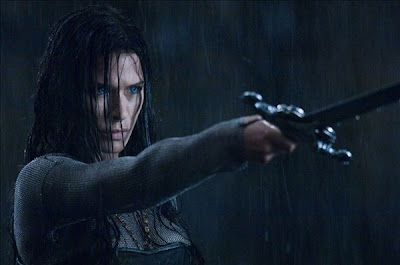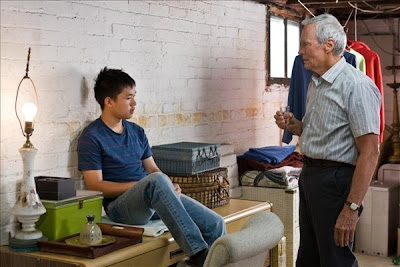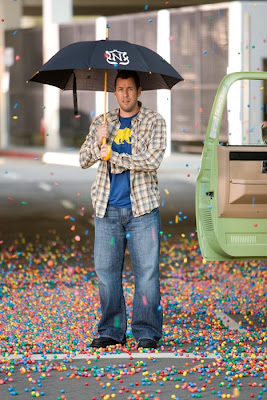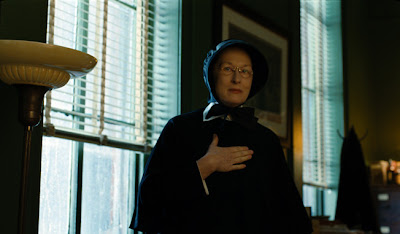
Bryan Mills: Liam Neeson
Kim: Maggie Grace
Jean-Claude: Olivier Rabourdin
St-Clair: Gérard Watkins
Stuart: Xander Berkley
Lenore: Famke Janssen
20th Century Fox presents a film directed by Pierre Morel. Written by Luc Besson & Robert Mark Kamen. Running time: 93 min. Rated PG-13 (for intense sequences of violence, disturbing thematic material, sexual content, some drug references and language).
The casting of a movie is such an interesting point if you really look at it. With most movies it’s not really something we question much. Harrison Ford is Indiana Jones. Matt Damon is Jason Bourne. But can you really imagine Christopher Walken as Han Solo? It almost happened, according to the Hollywood casting rumors. The thing with most casting decisions in action movies and thrillers is that they are casting the personality, not the character.
When I saw that Liam Neeson would be staring as an ex-black ops specialist who goes after his daughter’s kidnappers with a vengeance in the new thriller “Taken”, I thought he was an odd choice for an action star. He doesn’t seem to have the personality for it. As it turns out, Neeson (“Kinsey”) is the best thing about “Taken”. He doesn’t really have much of a personality in the film, and for a man that has done what his character has done for a living, that’s the way it should be.
Neeson’s Bryan Mills is a man who functions well in only one capacity. He is an expert in deception and manipulation, and in the intellectual and physical perfection that make him one of the best operatives the CIA ever lost to early retirement. As such he never had the time to develop the personality traits we’ve come to expect from the typical action hero.
He never developed any real relationships in his life. This is why he retired from the CIA. His wife has long since left him for a “perfect” man, and he is afraid his daughter is going to grow up never knowing him. So he retired from his life as a “preventer” to be closer to his daughter.
The opening passages of the movie are rather tedious in their insistence of establishing Bryan’s broken family. Lenore (Famke Janssen, “The Wackness”) imposes ridiculous rules on their daughter’s 17th birthday party. Maggie Grace (“Lost”) admirably and accurately under plays her own age as their daughter Kim, a naive, overly sheltered, rich kid. Xander Berkley (“Fracture”) is under utilized as her loving stepdad. This family broken by a father’s devotion to his secretive job has been played inside and out before and comes off here as whiny and unnecessary to set up the kidnapping that will obviously take place once Bryan allows Kim to go on an un-chaperoned Paris vacation with her 19-year-old girlfriend.
The movie finds its purpose during the kidnapping scene when Bryan overhears the kidnapping while in the middle of a phone conversation with Kim. He asks her to remain calm because “they’re going to take you,” but he is already working on rescuing her. Now, it becomes obvious why Neeson is perfectly cast for this film. He is so meticulous and matter of fact about what he must do to get his daughter back, how it must be done, and how to let her kidnappers know he means business.
“Taken” is all method with very little emotion behind it. Although Bryan is a father willing to do anything and hurt anybody—which he demonstrates mercilessly in one scene—to get his daughter back, emotions would make what he has to do impossible. Neeson is ruthless in his pursuit of his daughter’s kidnappers, running into resistance from even his former colleagues in the Parisian government. But there’s never any question that he’s capable of what he does here, which helps to explain why he’s so feared by even his friend Jean-Claude (Olivier Rabourdin, “The Messenger: The Story of Joan of Arc”). If this Neeson had been Qui-Gon Jinn, Darth Maul wouldn’t have stood a chance.
Director Pierre Morel may be new to American audiences, but he comes from a solid action background. Having directed the French thriller “District B-13” and acted as cinematographer on a number of other action films, Morel steers Luc Besson’s and Robert Mark Kamen’s script straight for the action angle. There is a car chase that proves, after however many years there have been car chases, that they can still be reinvented. The tension never drops from the point of the kidnapping because Morel never stops the action for the mundane details, like showing the audience when Bryan rents a car and hires an interpreter. Instead he gives us this information as the French authorities are literally trying keep up with him.
The film’s failing comes in the form of its emotional impact. While Neeson is exactly what he needs to be as an agent of relentless pursuit, the emotional connection with his goals is lacking. This is mostly a setup mistake. Instead of giving the audience a broken family, the screenwriters would have served their story better by having Bryan already accepted back into his family life after retirement. This would have given greater weight to his and his ex-wife’s loss and reunion with their daughter. But, for eighty percent of this movie, none of that really matters.
Kim: Maggie Grace
Jean-Claude: Olivier Rabourdin
St-Clair: Gérard Watkins
Stuart: Xander Berkley
Lenore: Famke Janssen
20th Century Fox presents a film directed by Pierre Morel. Written by Luc Besson & Robert Mark Kamen. Running time: 93 min. Rated PG-13 (for intense sequences of violence, disturbing thematic material, sexual content, some drug references and language).
The casting of a movie is such an interesting point if you really look at it. With most movies it’s not really something we question much. Harrison Ford is Indiana Jones. Matt Damon is Jason Bourne. But can you really imagine Christopher Walken as Han Solo? It almost happened, according to the Hollywood casting rumors. The thing with most casting decisions in action movies and thrillers is that they are casting the personality, not the character.
When I saw that Liam Neeson would be staring as an ex-black ops specialist who goes after his daughter’s kidnappers with a vengeance in the new thriller “Taken”, I thought he was an odd choice for an action star. He doesn’t seem to have the personality for it. As it turns out, Neeson (“Kinsey”) is the best thing about “Taken”. He doesn’t really have much of a personality in the film, and for a man that has done what his character has done for a living, that’s the way it should be.
Neeson’s Bryan Mills is a man who functions well in only one capacity. He is an expert in deception and manipulation, and in the intellectual and physical perfection that make him one of the best operatives the CIA ever lost to early retirement. As such he never had the time to develop the personality traits we’ve come to expect from the typical action hero.
He never developed any real relationships in his life. This is why he retired from the CIA. His wife has long since left him for a “perfect” man, and he is afraid his daughter is going to grow up never knowing him. So he retired from his life as a “preventer” to be closer to his daughter.
The opening passages of the movie are rather tedious in their insistence of establishing Bryan’s broken family. Lenore (Famke Janssen, “The Wackness”) imposes ridiculous rules on their daughter’s 17th birthday party. Maggie Grace (“Lost”) admirably and accurately under plays her own age as their daughter Kim, a naive, overly sheltered, rich kid. Xander Berkley (“Fracture”) is under utilized as her loving stepdad. This family broken by a father’s devotion to his secretive job has been played inside and out before and comes off here as whiny and unnecessary to set up the kidnapping that will obviously take place once Bryan allows Kim to go on an un-chaperoned Paris vacation with her 19-year-old girlfriend.
The movie finds its purpose during the kidnapping scene when Bryan overhears the kidnapping while in the middle of a phone conversation with Kim. He asks her to remain calm because “they’re going to take you,” but he is already working on rescuing her. Now, it becomes obvious why Neeson is perfectly cast for this film. He is so meticulous and matter of fact about what he must do to get his daughter back, how it must be done, and how to let her kidnappers know he means business.
“Taken” is all method with very little emotion behind it. Although Bryan is a father willing to do anything and hurt anybody—which he demonstrates mercilessly in one scene—to get his daughter back, emotions would make what he has to do impossible. Neeson is ruthless in his pursuit of his daughter’s kidnappers, running into resistance from even his former colleagues in the Parisian government. But there’s never any question that he’s capable of what he does here, which helps to explain why he’s so feared by even his friend Jean-Claude (Olivier Rabourdin, “The Messenger: The Story of Joan of Arc”). If this Neeson had been Qui-Gon Jinn, Darth Maul wouldn’t have stood a chance.
Director Pierre Morel may be new to American audiences, but he comes from a solid action background. Having directed the French thriller “District B-13” and acted as cinematographer on a number of other action films, Morel steers Luc Besson’s and Robert Mark Kamen’s script straight for the action angle. There is a car chase that proves, after however many years there have been car chases, that they can still be reinvented. The tension never drops from the point of the kidnapping because Morel never stops the action for the mundane details, like showing the audience when Bryan rents a car and hires an interpreter. Instead he gives us this information as the French authorities are literally trying keep up with him.
The film’s failing comes in the form of its emotional impact. While Neeson is exactly what he needs to be as an agent of relentless pursuit, the emotional connection with his goals is lacking. This is mostly a setup mistake. Instead of giving the audience a broken family, the screenwriters would have served their story better by having Bryan already accepted back into his family life after retirement. This would have given greater weight to his and his ex-wife’s loss and reunion with their daughter. But, for eighty percent of this movie, none of that really matters.
























